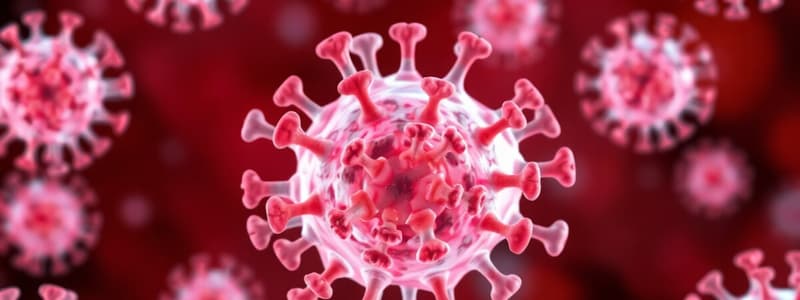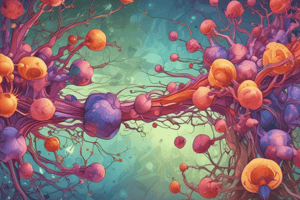Podcast
Questions and Answers
What is the primary mechanism by which phagocytes contribute to the inflammatory process and bridge innate and adaptive immunity?
What is the primary mechanism by which phagocytes contribute to the inflammatory process and bridge innate and adaptive immunity?
- Releasing antibodies that opsonize antigens for enhanced recognition.
- Directly neutralizing pathogens through cellular lysis.
- Secreting cytokines and presenting antigens, leading to immune cell activation. (correct)
- Activating complement pathways to directly eliminate pathogens.
How do cytokines maintain specificity in the immune system, considering their non-specific interaction with antigens?
How do cytokines maintain specificity in the immune system, considering their non-specific interaction with antigens?
- Cells express specific cytokine receptors, and secretion occurs during direct cell-to-cell interaction. (correct)
- Cytokines only affect cells with the exact matching MHC complex presenting the antigen.
- Cytokines undergo structural changes to specifically bind to their target cells based on antigen type.
- Cytokine secretion is directly regulated by the specific antigen recognized by the secreting cell.
Which of the following best describes the role of chemokines in the immune response?
Which of the following best describes the role of chemokines in the immune response?
- Enhancing phagocytosis by directly tagging pathogens for destruction.
- Inducing fever and acute phase protein synthesis in the liver.
- Stimulating B cells to differentiate into antibody-producing plasma cells.
- Directing the migration of leukocytes to sites of inflammation. (correct)
If a patient's immune response is found to have a deficiency in inducing fever and producing acute phase reactants during inflammation, which interleukin is most likely to be dysfunctional?
If a patient's immune response is found to have a deficiency in inducing fever and producing acute phase reactants during inflammation, which interleukin is most likely to be dysfunctional?
Which of the following is the most accurate description of how interleukin-1 contributes to acute inflammation?
Which of the following is the most accurate description of how interleukin-1 contributes to acute inflammation?
What is the primary function of Tumor Necrosis Factor beta (TNF-β) compared to Tumor Necrosis Factor alpha (TNF-α)?
What is the primary function of Tumor Necrosis Factor beta (TNF-β) compared to Tumor Necrosis Factor alpha (TNF-α)?
In a scenario where a patient exhibits muscle wasting (cachexia) during a chronic inflammatory condition, which cytokine is most likely contributing to this condition?
In a scenario where a patient exhibits muscle wasting (cachexia) during a chronic inflammatory condition, which cytokine is most likely contributing to this condition?
What role do adhesion molecules play in the context of acute inflammation, and which interleukin primarily stimulates their expression?
What role do adhesion molecules play in the context of acute inflammation, and which interleukin primarily stimulates their expression?
How does the synergistic action of cytokines influence immune responses compared to the effect of individual cytokines?
How does the synergistic action of cytokines influence immune responses compared to the effect of individual cytokines?
Which characteristic distinguishes interleukins from other types of cytokines, based on their primary function?
Which characteristic distinguishes interleukins from other types of cytokines, based on their primary function?
Flashcards
Cytokines
Cytokines
Proteins secreted by immune cells that mediate interactions between cells, influencing immune responses and inflammation.
Chemokines
Chemokines
A subgroup of cytokines involved in chemotaxis, guiding leukocytes to specific locations.
Cytokine-Mediated Responses
Cytokine-Mediated Responses
Development of immune responses, induction of inflammation, hematopoiesis regulation, control of cell proliferation/differentiation, and the healing process.
Antigen-Presenting Cells (APCs)
Antigen-Presenting Cells (APCs)
Signup and view all the flashcards
Interleukins
Interleukins
Signup and view all the flashcards
Interleukin-1 (IL-1)
Interleukin-1 (IL-1)
Signup and view all the flashcards
Interleukin-6 (IL-6)
Interleukin-6 (IL-6)
Signup and view all the flashcards
Interleukin-17 (IL-17)
Interleukin-17 (IL-17)
Signup and view all the flashcards
Tumor Necrosis Factor Alpha (TNF-α)
Tumor Necrosis Factor Alpha (TNF-α)
Signup and view all the flashcards
Tumor Necrosis Factor Beta (TNF-β)
Tumor Necrosis Factor Beta (TNF-β)
Signup and view all the flashcards
Study Notes
- Cytokines are secreted by cells like T cells, dendritic cells, and macrophages, activating a network of interacting cells.
- Over 200 proteins have cytokine activity.
- Cytokines are secreted by leukocytes and other cells involved in innate/adaptive immunity and inflammation.
- Chemokines, a subgroup of low molecular weight cytokines, facilitate chemotaxis (chemically induced migration of leukocytes).
Physiologic Responses Mediated by Cytokines
- Development of cellular and humoral immune responses
- Induction of inflammatory responses
- Regulation of hematopoiesis
- Control of cellular proliferation and differentiation
- The healing process
- Cytokines act in an antigen-nonspecific manner.
Phagocytes Role
- Phagocytes are antigen-presenting cells bridging innate and adaptive immunity.
- Inflammatory processes are driven by antigen recognition and presentation through phagocytic cells.
- Cytokines and chemokines mediate these processes.
- Target cells are exposed to multiple cytokines that regulate through synergistic or antagonistic effects.
- Specificity is maintained by regulation of cytokine receptors or secretion timing.
- In macrophages, interaction with target cells occurs during antigen presentation or T cell receptor recognition of antigen-MHC complex.
- Phagocytosis upregulates pro-inflammatory cytokines like IL-1, IL-6, IL-12, and TNF-alpha.
Interleukins
- Interleukins mediate communication between leukocytes.
- There are at least 38 interleukins
- Interleukins are numbered according to their discovery order.
- Interleukins are involved in the pathogenesis of human inflammatory and autoimmune diseases.
- Key interleukins and cytokines in acute inflammation include IL-1, IL-6, IL-17 alpha, TNF-alpha, and chemokines.
- Macrophages produce IL-1, IL-6, and TNF-alpha, while T-lymphocytes produce IL-17 and TNF-beta.
Specific Interleukins
- Interleukin-1 (IL-1) is produced by macrophages, fibroblasts, endothelial cells, and some epithelial cells.
- Interleukin-6 (IL-6) is synthesized and produced by T cells.
- Interleukin-17 (IL-17) is produced by T lymphocytes.
Functions of Interleukins
- IL-1 stimulates the expression of adhesion molecules, aiding leukocyte adhesion, and promotes neutrophil and macrophage immigration.
- IL-1 aids in the synthesis of other cytokines (e.g., IL-2).
- IL-1 induces fever by affecting the hypothalamus and is also known as endogenous pyrogen.
- IL-6 has similar functions to IL-1 and is responsible for the systemic response to inflammation, including fever and production of acute-phase reactants (e.g., C-reactive protein).
- IL-6 induces B cells to differentiate into antibody-producing plasma cells.
- IL-17 recruits neutrophils and monocytes and stimulates the secretion of other cytokines (e.g., IL-6), colony-stimulating factors, TNF, and chemokines.
Tumor Necrosis Factor (TNF)
- TNF-alpha is produced by macrophages, fibroblasts, endothelial cells, and epithelial cells.
- Its functions overlap with IL-1, including stimulating adhesion molecule expression, recruiting phagocytes and macrophages, secreting cytokines, and inducing fever.
- TNF-alpha regulates energy balance by promoting lipid and protein catabolism and suppresses appetite.
- TNF-alpha is responsible for muscle wasting (cachexia) in some conditions and tumors.
- TNF-beta, produced by B and T lymphocytes, mediates cellular cytotoxicity.
- TNF-beta is important in the development of the spleen and thymus but not in acute inflammation.
Chemokines
- Chemokines are produced by macrophages and endothelial cells.
- Chemokines are small proteins (8-10 kDa) that act as chemoattractants for leukocytes.
- They bind to seven transmembrane G protein-coupled receptors and direct the movement of circulating leukocytes to sites of inflammation.
Studying That Suits You
Use AI to generate personalized quizzes and flashcards to suit your learning preferences.




